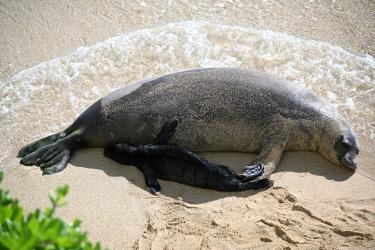Monitoring threatened and endangered species is critical to supporting their protection and recovery. Small field teams of researchers spend 2 to 6 months each year in the Papahānaumokuākea Marine National Monument to monitor Hawaiian monk seal and green sea turtle populations at:
- Lalo (French Frigate Shoals)
- Kamole (Laysan Island)
- Kapou (Lisianski Island)
- Manawai (Pearl and Hermes Atoll)
- Kuaihelani (Midway Atoll)
- Hōlanikū (Kure Atoll)

Precious Populations
NOAA field researchers have traveled to Lalo for the last 50 years to monitor honu (Hawaiian green sea turtles) that migrate there to mate and lay their eggs. Approximately 96 percent of honu in Hawai‘i use Lalo as their nesting grounds. Having a research team there during the summer nesting months is important for monitoring the entire population.
The Endangered Species Act designated the Hawaiian monk seal as endangered in 1976. The historical rapid decline of the Hawaiian monk seal population urged immediate action to help preserve the species. In the early 1980s, NOAA developed a standardized monitoring program to assess the Hawaiian monk seal population in Papahānaumokuākea. This created the foundation of the work NOAA continues to do to this day.
Deployment and Life in the Field
Field camp preparations begin long before the team sets sail. Extra research staff are recruited and brought aboard in support of this large effort. Prior to departure, teams receive 4 to 6 weeks of training that includes specialized wilderness first aid instruction and a NOAA Motorboat Operator Certification Course.
Once the team leaves Honolulu, it takes 3 days to get to Lalo, the first camp site. Most islands within the monument are roughly a 12-hour transit apart. Once on island, field teams set up their camps and begin surveys. Kuaihelani is accessible by plane and has buildings and more amenities than the other islands. All food, water, equipment, and supplies are brought with the field teams during their initial deployment and must last for the whole summer. Strict biosecurity procedures are followed when preparing tools and gear for deployment to the monument. This ensures that non-native species (insects and seeds) are not transported and introduced to these ecologically and culturally significant areas.
Staying physically, emotionally, and mentally healthy are key to keeping up with the high-tempo, strenuous field work. Team members are encouraged to take time to absorb the beauty and importance of their surroundings, especially since Papahānaumokuākea is not easily or regularly accessible. The privilege of working in this important space is anchored in gratitude and responsibility.
Research Objectives
Hawaiian monk seal and green sea turtle research objectives for all sites include:
- Measuring and tagging all weaned seal pups and nesting and basking turtles
- Identifying all individuals in each subpopulation
- Conducting systematic beach counts of seals and turtles
- Documenting births, deaths, serious injuries, and entanglement in marine debris
- Reuniting separated seal mother-pup pairs, disentangling seals, and conducting other life-saving interventions to increase seal survival
- Conducting necropsies on dead seals and turtles
- Collecting and removing marine debris
- Participating in huli‘ia observational data
Other objectives may vary between locations, subpopulations, and seasons. For example, at locations where male seal aggression may result in severe injuries and even death of females and immature seals, the field teams focus on observing aggressive behavior, identifying the aggressive males, and intervening when appropriate (like treatment of injured seals). At Lalo, where seal pups are particularly susceptible to shark attacks, researchers may monitor shark/seal interactions and move newly weaned pups from areas of high to low predation risk within the atoll.
A Legacy of Conservation Science
At the end of each field season, researchers analyze their collected data to assess population statuses and guide future recovery efforts. Annual field camps in the Papahānaumokuākea Marine National Monument have resulted in important long-term datasets and have greatly increased our knowledge of the natural history of these species. In recent years we’ve seen slow and steady growth in the Hawaiian monk seal population, and approximately 30 percent of seals alive today are here because of an intervention that either saved their life or the life of their mother or grandmother. By working in the monument during the summer nesting months, researchers have been able to monitor the majority of Hawai‘i honu.
The continued success of annual field camp seasons is propelled forward through the dedication and passion of our scientists and partners, and support of our community. We look forward to continuing this conservation science legacy.
Join Us in the Field
Are you interested in joining our Hawaiian monk seal or sea turtle team and studying these incredible animals? Seasonal research technicians and assistants are hired annually through the Research Corporation of the University of Hawai‘i in the fall for the next spring/summer field season. Keep an eye out on our social media and website for opportunities to join us in the field! For questions and additional information please contact pifsc.info@noaa.gov. At other times of the year, our partners at the U.S. Fish and Wildlife Service or Department of Land and Natural Resources/Kure Atoll Conservancy may have positions open, and we work closely together on conservation of protected species in this special place.



